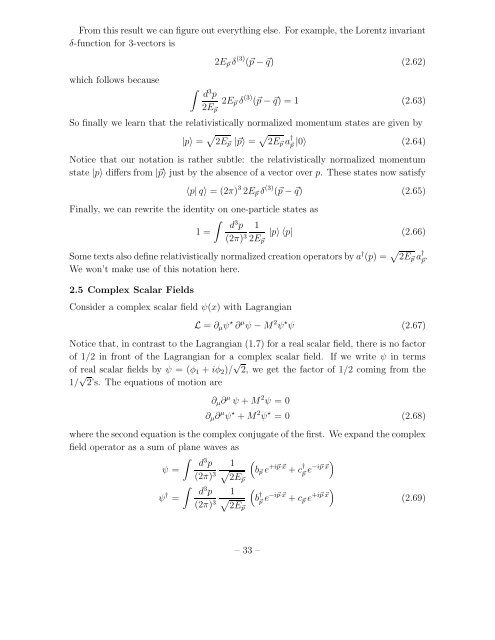- Page 5 and 6: 4.7.2 Some Useful Formulae: Inner a
- Page 7 and 8: 0. Introduction“There are no real
- Page 9 and 10: At distances shorter than this, the
- Page 11 and 12: which allows us to express all dime
- Page 13 and 14: 1. Classical Field TheoryIn this fi
- Page 15 and 16: and the potential energy of the fie
- Page 17 and 18: 1.2 Lorentz InvarianceThe laws of N
- Page 19 and 20: Example 3: Maxwell’s EquationsUnd
- Page 21 and 22: (where the sign in the field transf
- Page 23 and 24: from which we see thatδφ = −ω
- Page 25 and 26: Another Cute TrickThere is a quick
- Page 27 and 28: 2. Free Fields“The career of a yo
- Page 29 and 30: Substituting into the above express
- Page 31 and 32: Hmmmm. We’ve found a delta-functi
- Page 33 and 34: 2.3.2 The Casimir Effect“I mentio
- Page 35 and 36: This is still infinite in the limit
- Page 37: This space is known as a Fock space
- Page 41 and 42: 2.6 The Heisenberg PictureAlthough
- Page 43 and 44: But what about arbitrary spacetime
- Page 45 and 46: where T stands for time ordering, p
- Page 47 and 48: Im(p 0)Im(p 0)−E p+ E pRe(p 0)−
- Page 49 and 50: We may expand ψ(⃗x) as a Fourier
- Page 51 and 52: which confirms (2.120). So we learn
- Page 53 and 54: 3. Interacting FieldsThe free field
- Page 55 and 56: means that for experiments at small
- Page 57 and 58: The interaction picture is a hybrid
- Page 59 and 60: Actually these last two terms doubl
- Page 61 and 62: • Obviously we can’t cope with
- Page 63 and 64: where the ± signs on φ ± make li
- Page 65 and 66: Now, using Wick’s theorem we see
- Page 67 and 68: solid lines to denote its charge; w
- Page 69 and 70: p 1p 1/p 1p 1/p 2p 2/p 2p 2/Figure
- Page 71 and 72: Notice that the momentum dependence
- Page 73 and 74: 3.5.2 The Yukawa PotentialSo far we
- Page 75 and 76: where we’ve introduced the dimens
- Page 77 and 78: • We do not consider diagrams wit
- Page 79 and 80: is the probability for the transiti
- Page 81 and 82: meaning that the flux is given in t
- Page 83 and 84: But the last term vanishes. This fo
- Page 85 and 86: the S-matrix elements, where we wer
- Page 87 and 88: 4. The Dirac Equation“A great dea
- Page 89 and 90:
where we have suppressed the matrix
- Page 91 and 92:
4.1.1 SpinorsThe S µν are 4 × 4
- Page 93 and 94:
which can be anti-hermitian if all
- Page 95 and 96:
so the requirement (4.44) becomes
- Page 97 and 98:
4.4 Chiral SpinorsWhen we’ve need
- Page 99 and 100:
4.4.2 γ 5The Lorentz group matrice
- Page 101 and 102:
4.4.4 Chiral InteractionsLet’s no
- Page 103 and 104:
where we’ve made use of the prope
- Page 105 and 106:
which, after direct substitution, t
- Page 107 and 108:
for any 2-component spinor ξ which
- Page 109 and 110:
HelicityThe helicity operator is th
- Page 111 and 112:
Proof:2∑s=1u s (⃗p) ū s (⃗p)
- Page 113 and 114:
Claim: The field commutation relati
- Page 115 and 116:
The δ (3) term is familiar and eas
- Page 117 and 118:
Let’s pause our discussion to mak
- Page 119 and 120:
In what follows we will often drop
- Page 121 and 122:
5.6 Yukawa TheoryThe interaction be
- Page 123 and 124:
where we’ve put the φ propagator
- Page 125 and 126:
The denominators in each term are d
- Page 127 and 128:
Finally, we can also compute the sc
- Page 129 and 130:
We could again try to take the non-
- Page 131 and 132:
These remain true even in the prese
- Page 133 and 134:
line can be reached by a gauge tran
- Page 135 and 136:
which means that ⃗ ξ is perpendi
- Page 137 and 138:
6.2.2 Lorentz GaugeWe could try to
- Page 139 and 140:
The minus signs here are odd to say
- Page 141 and 142:
a 1,2 †⃗p, while |φ〉 contain
- Page 143 and 144:
where we’ve introduced a coupling
- Page 145 and 146:
Let’s now consider a complex scal
- Page 147 and 148:
6.4.1 Naive Feynman RulesWe want to
- Page 149 and 150:
which is the claimed result. You ca
- Page 151 and 152:
Electron ScatteringElectron scatter
- Page 153 and 154:
momenta, we have the amplitudes giv
- Page 155:
6.7 AfterwordIn this course, we hav
















